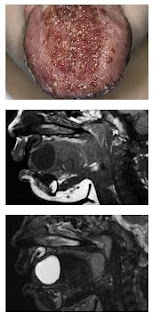Etiology • A benign proliferation of lymphatic vasculature • Usually congenital in nature
Clinical Presentation • Superficial or deep in location • Typically waxes and wanes in size • Most commonly involves the tongue followed by lips, buccal
mucosa, palate • Facial asymmetry may be a presenting sign. • Superficial mucosal lymphangiomas resemble caviar or frog’s
eggs. • Deeper lesions present as painless fluctuant masses such as
Clinical Presentation • Superficial or deep in location • Typically waxes and wanes in size • Most commonly involves the tongue followed by lips, buccal
mucosa, palate • Facial asymmetry may be a presenting sign. • Superficial mucosal lymphangiomas resemble caviar or frog’s
eggs. • Deeper lesions present as painless fluctuant masses such as
macroglossia. • Often combined with blood vessels • Rare variant may occur bilaterally on mandibular alveolar
ridge of neonates
Diagnosis • Biopsy • Lymphangiography
Differential Diagnosis • Neurofibroma (deep) • Hemihypertrophy syndromes
Treatment • Excision • If large lesions are stable, observation • Sclerotherapy
Prognosis • Variable, depending upon depth and extent of lesion • Cavernous variant has guarded prognosis
